Review Essay: Big Data Analytics and Enterprise Information Systems
VerifiedAdded on 2022/09/14
|12
|3181
|20
Essay
AI Summary
This essay delves into the critical relationship between Big Data Analytics and Enterprise Information Systems (EIS). It explores the ontology of Big Data Analytics, emphasizing its role in examining, summarizing, and drawing conclusions from data to enhance organizational growth and communication. The paper examines implementation models, including the integration of Big Data Analytics with SCM, KM, and CRM systems, and highlights how these systems leverage data warehouses and statistical modeling to improve decision-making. The essay underscores the benefits of Big Data Analytics in areas such as marketing intelligence, corporate governance, and operational efficiency, while also addressing the challenges of data collection and the need for skilled data analysis. The integration of EIS and big data is shown to widen the scope of expertise and positively impact business performance, customer satisfaction, and data accessibility, ultimately enabling organizations to make smarter decisions and achieve their strategic goals.
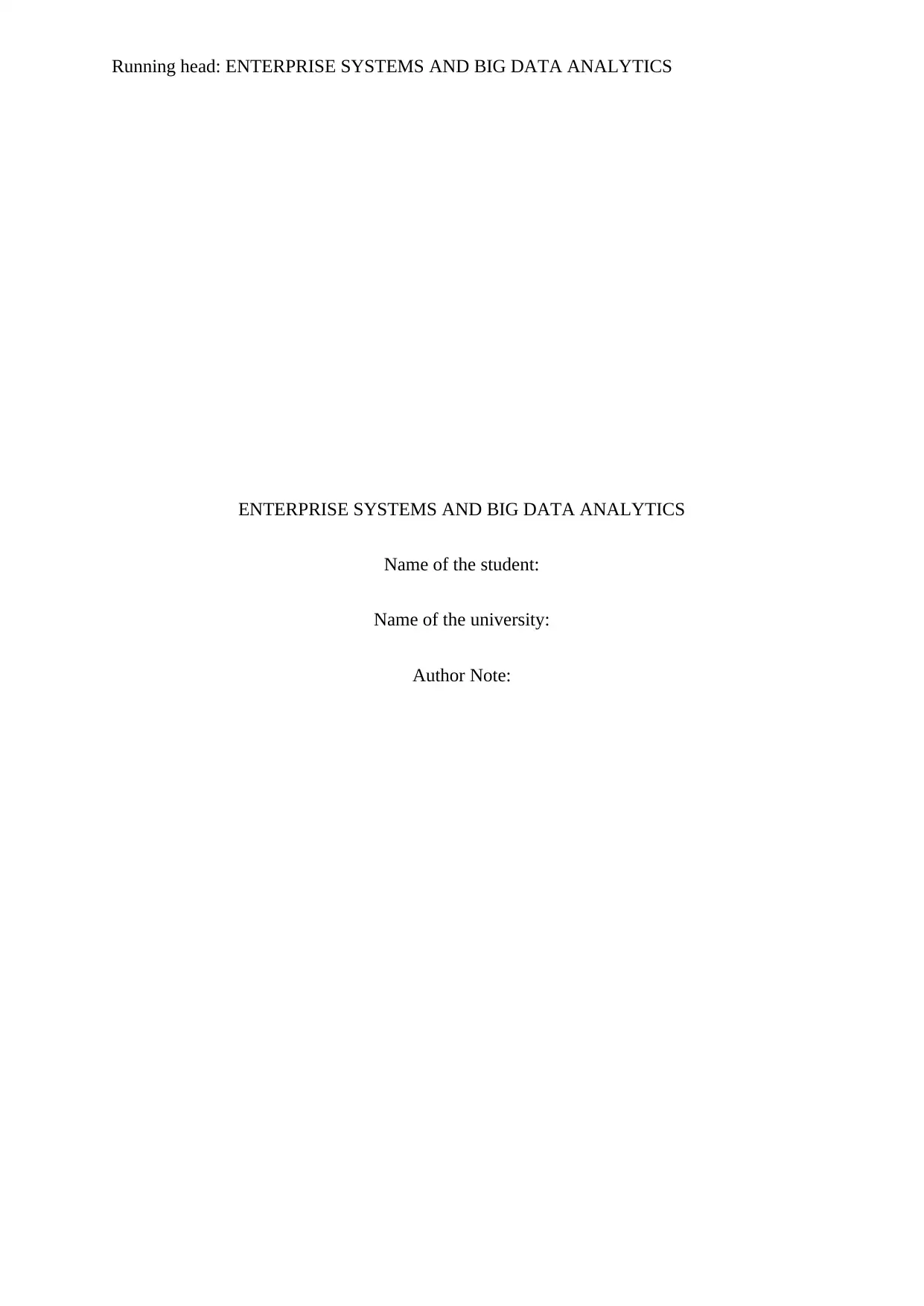
Running head: ENTERPRISE SYSTEMS AND BIG DATA ANALYTICS
ENTERPRISE SYSTEMS AND BIG DATA ANALYTICS
Name of the student:
Name of the university:
Author Note:
ENTERPRISE SYSTEMS AND BIG DATA ANALYTICS
Name of the student:
Name of the university:
Author Note:
Paraphrase This Document
Need a fresh take? Get an instant paraphrase of this document with our AI Paraphraser
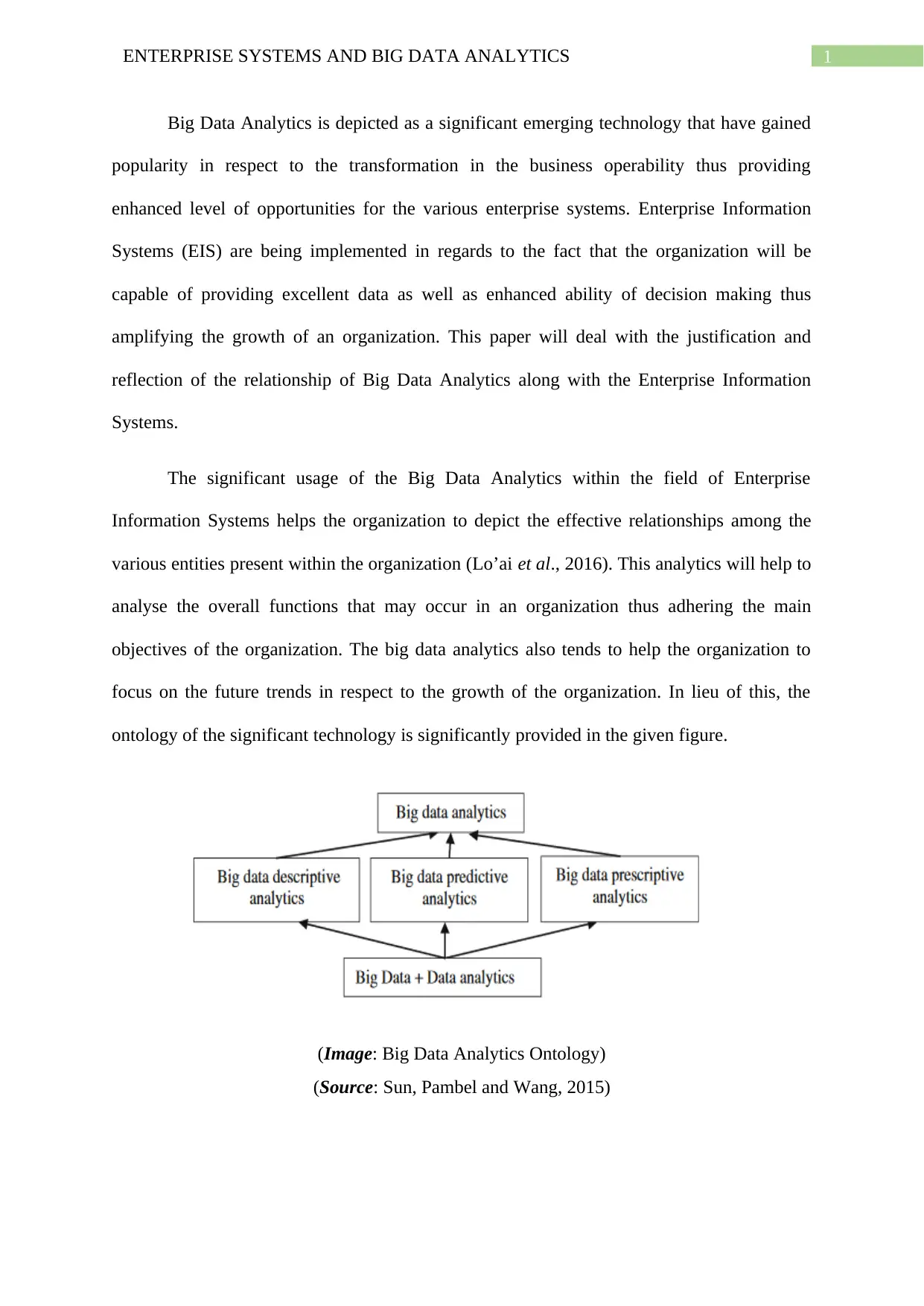
1ENTERPRISE SYSTEMS AND BIG DATA ANALYTICS
Big Data Analytics is depicted as a significant emerging technology that have gained
popularity in respect to the transformation in the business operability thus providing
enhanced level of opportunities for the various enterprise systems. Enterprise Information
Systems (EIS) are being implemented in regards to the fact that the organization will be
capable of providing excellent data as well as enhanced ability of decision making thus
amplifying the growth of an organization. This paper will deal with the justification and
reflection of the relationship of Big Data Analytics along with the Enterprise Information
Systems.
The significant usage of the Big Data Analytics within the field of Enterprise
Information Systems helps the organization to depict the effective relationships among the
various entities present within the organization (Lo’ai et al., 2016). This analytics will help to
analyse the overall functions that may occur in an organization thus adhering the main
objectives of the organization. The big data analytics also tends to help the organization to
focus on the future trends in respect to the growth of the organization. In lieu of this, the
ontology of the significant technology is significantly provided in the given figure.
(Image: Big Data Analytics Ontology)
(Source: Sun, Pambel and Wang, 2015)
Big Data Analytics is depicted as a significant emerging technology that have gained
popularity in respect to the transformation in the business operability thus providing
enhanced level of opportunities for the various enterprise systems. Enterprise Information
Systems (EIS) are being implemented in regards to the fact that the organization will be
capable of providing excellent data as well as enhanced ability of decision making thus
amplifying the growth of an organization. This paper will deal with the justification and
reflection of the relationship of Big Data Analytics along with the Enterprise Information
Systems.
The significant usage of the Big Data Analytics within the field of Enterprise
Information Systems helps the organization to depict the effective relationships among the
various entities present within the organization (Lo’ai et al., 2016). This analytics will help to
analyse the overall functions that may occur in an organization thus adhering the main
objectives of the organization. The big data analytics also tends to help the organization to
focus on the future trends in respect to the growth of the organization. In lieu of this, the
ontology of the significant technology is significantly provided in the given figure.
(Image: Big Data Analytics Ontology)
(Source: Sun, Pambel and Wang, 2015)
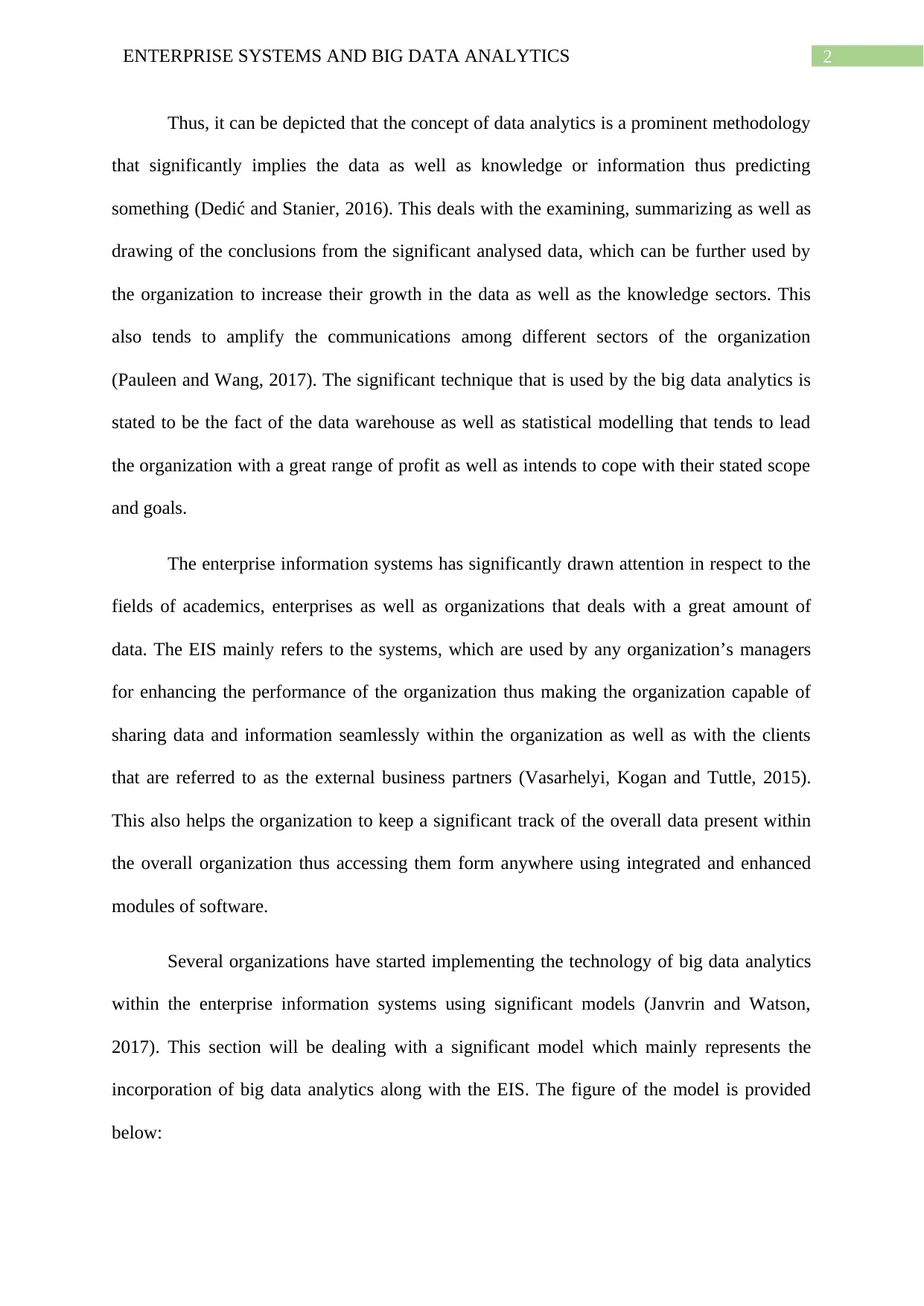
2ENTERPRISE SYSTEMS AND BIG DATA ANALYTICS
Thus, it can be depicted that the concept of data analytics is a prominent methodology
that significantly implies the data as well as knowledge or information thus predicting
something (Dedić and Stanier, 2016). This deals with the examining, summarizing as well as
drawing of the conclusions from the significant analysed data, which can be further used by
the organization to increase their growth in the data as well as the knowledge sectors. This
also tends to amplify the communications among different sectors of the organization
(Pauleen and Wang, 2017). The significant technique that is used by the big data analytics is
stated to be the fact of the data warehouse as well as statistical modelling that tends to lead
the organization with a great range of profit as well as intends to cope with their stated scope
and goals.
The enterprise information systems has significantly drawn attention in respect to the
fields of academics, enterprises as well as organizations that deals with a great amount of
data. The EIS mainly refers to the systems, which are used by any organization’s managers
for enhancing the performance of the organization thus making the organization capable of
sharing data and information seamlessly within the organization as well as with the clients
that are referred to as the external business partners (Vasarhelyi, Kogan and Tuttle, 2015).
This also helps the organization to keep a significant track of the overall data present within
the overall organization thus accessing them form anywhere using integrated and enhanced
modules of software.
Several organizations have started implementing the technology of big data analytics
within the enterprise information systems using significant models (Janvrin and Watson,
2017). This section will be dealing with a significant model which mainly represents the
incorporation of big data analytics along with the EIS. The figure of the model is provided
below:
Thus, it can be depicted that the concept of data analytics is a prominent methodology
that significantly implies the data as well as knowledge or information thus predicting
something (Dedić and Stanier, 2016). This deals with the examining, summarizing as well as
drawing of the conclusions from the significant analysed data, which can be further used by
the organization to increase their growth in the data as well as the knowledge sectors. This
also tends to amplify the communications among different sectors of the organization
(Pauleen and Wang, 2017). The significant technique that is used by the big data analytics is
stated to be the fact of the data warehouse as well as statistical modelling that tends to lead
the organization with a great range of profit as well as intends to cope with their stated scope
and goals.
The enterprise information systems has significantly drawn attention in respect to the
fields of academics, enterprises as well as organizations that deals with a great amount of
data. The EIS mainly refers to the systems, which are used by any organization’s managers
for enhancing the performance of the organization thus making the organization capable of
sharing data and information seamlessly within the organization as well as with the clients
that are referred to as the external business partners (Vasarhelyi, Kogan and Tuttle, 2015).
This also helps the organization to keep a significant track of the overall data present within
the overall organization thus accessing them form anywhere using integrated and enhanced
modules of software.
Several organizations have started implementing the technology of big data analytics
within the enterprise information systems using significant models (Janvrin and Watson,
2017). This section will be dealing with a significant model which mainly represents the
incorporation of big data analytics along with the EIS. The figure of the model is provided
below:
⊘ This is a preview!⊘
Do you want full access?
Subscribe today to unlock all pages.

Trusted by 1+ million students worldwide
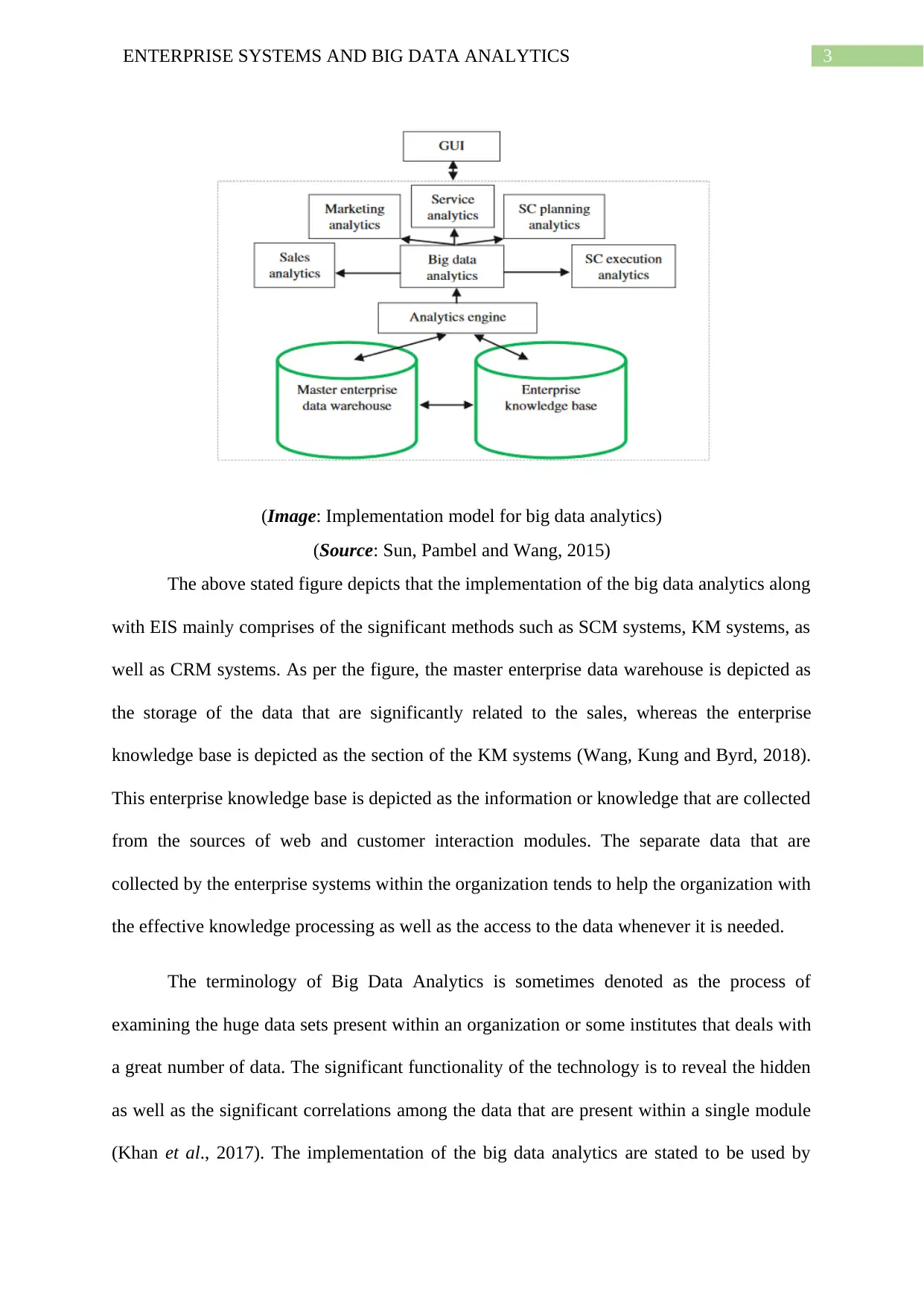
3ENTERPRISE SYSTEMS AND BIG DATA ANALYTICS
(Image: Implementation model for big data analytics)
(Source: Sun, Pambel and Wang, 2015)
The above stated figure depicts that the implementation of the big data analytics along
with EIS mainly comprises of the significant methods such as SCM systems, KM systems, as
well as CRM systems. As per the figure, the master enterprise data warehouse is depicted as
the storage of the data that are significantly related to the sales, whereas the enterprise
knowledge base is depicted as the section of the KM systems (Wang, Kung and Byrd, 2018).
This enterprise knowledge base is depicted as the information or knowledge that are collected
from the sources of web and customer interaction modules. The separate data that are
collected by the enterprise systems within the organization tends to help the organization with
the effective knowledge processing as well as the access to the data whenever it is needed.
The terminology of Big Data Analytics is sometimes denoted as the process of
examining the huge data sets present within an organization or some institutes that deals with
a great number of data. The significant functionality of the technology is to reveal the hidden
as well as the significant correlations among the data that are present within a single module
(Khan et al., 2017). The implementation of the big data analytics are stated to be used by
(Image: Implementation model for big data analytics)
(Source: Sun, Pambel and Wang, 2015)
The above stated figure depicts that the implementation of the big data analytics along
with EIS mainly comprises of the significant methods such as SCM systems, KM systems, as
well as CRM systems. As per the figure, the master enterprise data warehouse is depicted as
the storage of the data that are significantly related to the sales, whereas the enterprise
knowledge base is depicted as the section of the KM systems (Wang, Kung and Byrd, 2018).
This enterprise knowledge base is depicted as the information or knowledge that are collected
from the sources of web and customer interaction modules. The separate data that are
collected by the enterprise systems within the organization tends to help the organization with
the effective knowledge processing as well as the access to the data whenever it is needed.
The terminology of Big Data Analytics is sometimes denoted as the process of
examining the huge data sets present within an organization or some institutes that deals with
a great number of data. The significant functionality of the technology is to reveal the hidden
as well as the significant correlations among the data that are present within a single module
(Khan et al., 2017). The implementation of the big data analytics are stated to be used by
Paraphrase This Document
Need a fresh take? Get an instant paraphrase of this document with our AI Paraphraser
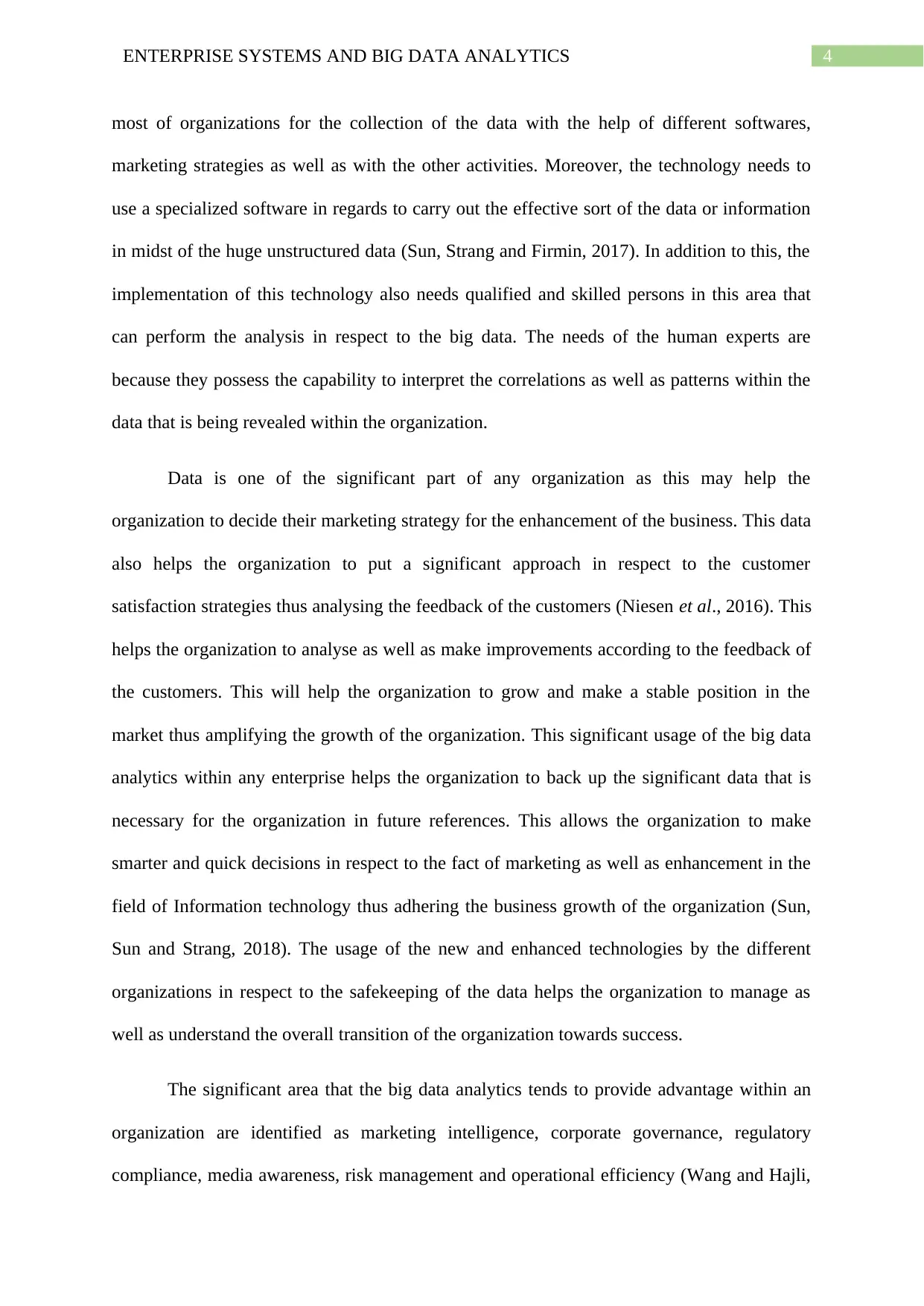
4ENTERPRISE SYSTEMS AND BIG DATA ANALYTICS
most of organizations for the collection of the data with the help of different softwares,
marketing strategies as well as with the other activities. Moreover, the technology needs to
use a specialized software in regards to carry out the effective sort of the data or information
in midst of the huge unstructured data (Sun, Strang and Firmin, 2017). In addition to this, the
implementation of this technology also needs qualified and skilled persons in this area that
can perform the analysis in respect to the big data. The needs of the human experts are
because they possess the capability to interpret the correlations as well as patterns within the
data that is being revealed within the organization.
Data is one of the significant part of any organization as this may help the
organization to decide their marketing strategy for the enhancement of the business. This data
also helps the organization to put a significant approach in respect to the customer
satisfaction strategies thus analysing the feedback of the customers (Niesen et al., 2016). This
helps the organization to analyse as well as make improvements according to the feedback of
the customers. This will help the organization to grow and make a stable position in the
market thus amplifying the growth of the organization. This significant usage of the big data
analytics within any enterprise helps the organization to back up the significant data that is
necessary for the organization in future references. This allows the organization to make
smarter and quick decisions in respect to the fact of marketing as well as enhancement in the
field of Information technology thus adhering the business growth of the organization (Sun,
Sun and Strang, 2018). The usage of the new and enhanced technologies by the different
organizations in respect to the safekeeping of the data helps the organization to manage as
well as understand the overall transition of the organization towards success.
The significant area that the big data analytics tends to provide advantage within an
organization are identified as marketing intelligence, corporate governance, regulatory
compliance, media awareness, risk management and operational efficiency (Wang and Hajli,
most of organizations for the collection of the data with the help of different softwares,
marketing strategies as well as with the other activities. Moreover, the technology needs to
use a specialized software in regards to carry out the effective sort of the data or information
in midst of the huge unstructured data (Sun, Strang and Firmin, 2017). In addition to this, the
implementation of this technology also needs qualified and skilled persons in this area that
can perform the analysis in respect to the big data. The needs of the human experts are
because they possess the capability to interpret the correlations as well as patterns within the
data that is being revealed within the organization.
Data is one of the significant part of any organization as this may help the
organization to decide their marketing strategy for the enhancement of the business. This data
also helps the organization to put a significant approach in respect to the customer
satisfaction strategies thus analysing the feedback of the customers (Niesen et al., 2016). This
helps the organization to analyse as well as make improvements according to the feedback of
the customers. This will help the organization to grow and make a stable position in the
market thus amplifying the growth of the organization. This significant usage of the big data
analytics within any enterprise helps the organization to back up the significant data that is
necessary for the organization in future references. This allows the organization to make
smarter and quick decisions in respect to the fact of marketing as well as enhancement in the
field of Information technology thus adhering the business growth of the organization (Sun,
Sun and Strang, 2018). The usage of the new and enhanced technologies by the different
organizations in respect to the safekeeping of the data helps the organization to manage as
well as understand the overall transition of the organization towards success.
The significant area that the big data analytics tends to provide advantage within an
organization are identified as marketing intelligence, corporate governance, regulatory
compliance, media awareness, risk management and operational efficiency (Wang and Hajli,
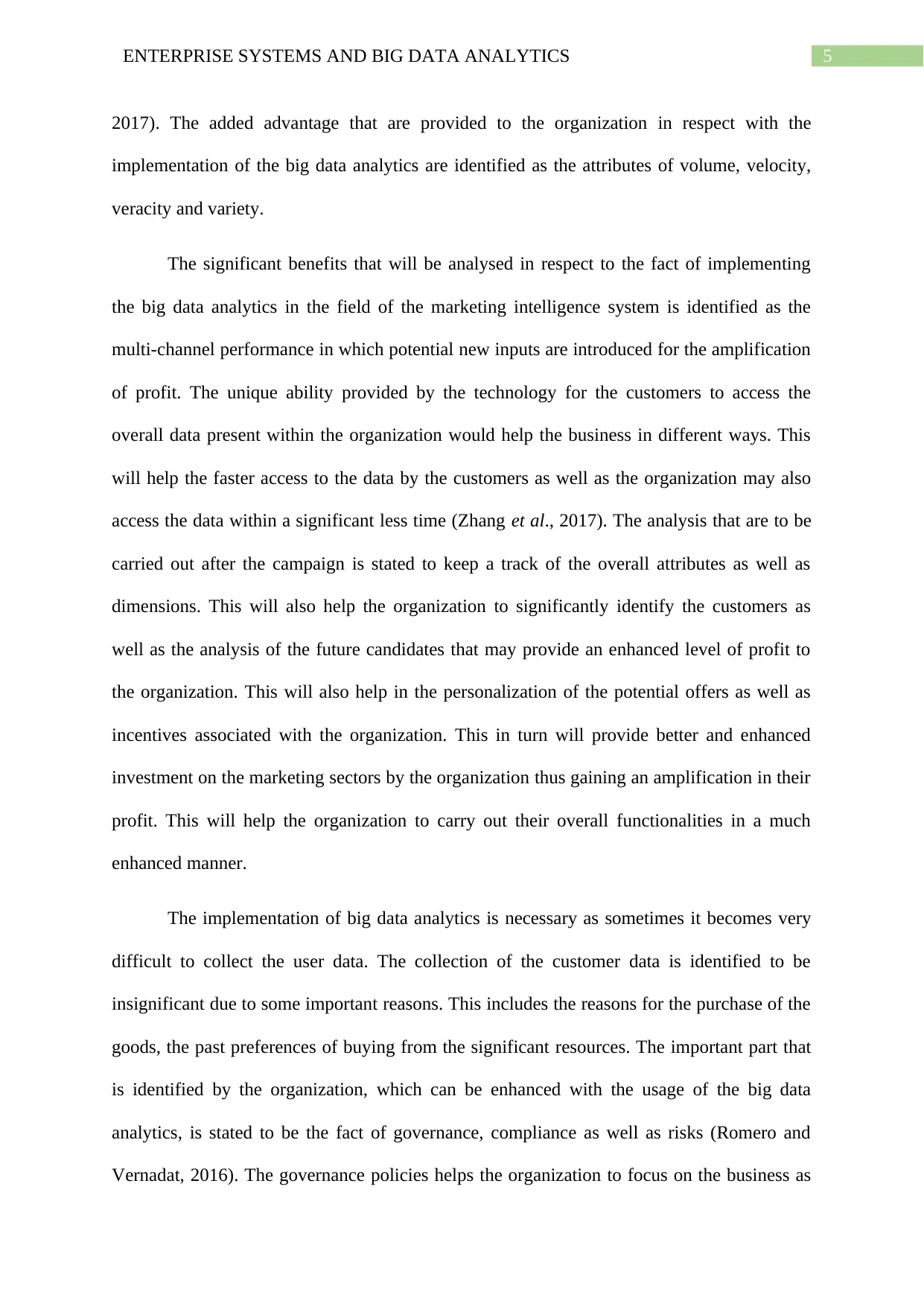
5ENTERPRISE SYSTEMS AND BIG DATA ANALYTICS
2017). The added advantage that are provided to the organization in respect with the
implementation of the big data analytics are identified as the attributes of volume, velocity,
veracity and variety.
The significant benefits that will be analysed in respect to the fact of implementing
the big data analytics in the field of the marketing intelligence system is identified as the
multi-channel performance in which potential new inputs are introduced for the amplification
of profit. The unique ability provided by the technology for the customers to access the
overall data present within the organization would help the business in different ways. This
will help the faster access to the data by the customers as well as the organization may also
access the data within a significant less time (Zhang et al., 2017). The analysis that are to be
carried out after the campaign is stated to keep a track of the overall attributes as well as
dimensions. This will also help the organization to significantly identify the customers as
well as the analysis of the future candidates that may provide an enhanced level of profit to
the organization. This will also help in the personalization of the potential offers as well as
incentives associated with the organization. This in turn will provide better and enhanced
investment on the marketing sectors by the organization thus gaining an amplification in their
profit. This will help the organization to carry out their overall functionalities in a much
enhanced manner.
The implementation of big data analytics is necessary as sometimes it becomes very
difficult to collect the user data. The collection of the customer data is identified to be
insignificant due to some important reasons. This includes the reasons for the purchase of the
goods, the past preferences of buying from the significant resources. The important part that
is identified by the organization, which can be enhanced with the usage of the big data
analytics, is stated to be the fact of governance, compliance as well as risks (Romero and
Vernadat, 2016). The governance policies helps the organization to focus on the business as
2017). The added advantage that are provided to the organization in respect with the
implementation of the big data analytics are identified as the attributes of volume, velocity,
veracity and variety.
The significant benefits that will be analysed in respect to the fact of implementing
the big data analytics in the field of the marketing intelligence system is identified as the
multi-channel performance in which potential new inputs are introduced for the amplification
of profit. The unique ability provided by the technology for the customers to access the
overall data present within the organization would help the business in different ways. This
will help the faster access to the data by the customers as well as the organization may also
access the data within a significant less time (Zhang et al., 2017). The analysis that are to be
carried out after the campaign is stated to keep a track of the overall attributes as well as
dimensions. This will also help the organization to significantly identify the customers as
well as the analysis of the future candidates that may provide an enhanced level of profit to
the organization. This will also help in the personalization of the potential offers as well as
incentives associated with the organization. This in turn will provide better and enhanced
investment on the marketing sectors by the organization thus gaining an amplification in their
profit. This will help the organization to carry out their overall functionalities in a much
enhanced manner.
The implementation of big data analytics is necessary as sometimes it becomes very
difficult to collect the user data. The collection of the customer data is identified to be
insignificant due to some important reasons. This includes the reasons for the purchase of the
goods, the past preferences of buying from the significant resources. The important part that
is identified by the organization, which can be enhanced with the usage of the big data
analytics, is stated to be the fact of governance, compliance as well as risks (Romero and
Vernadat, 2016). The governance policies helps the organization to focus on the business as
⊘ This is a preview!⊘
Do you want full access?
Subscribe today to unlock all pages.

Trusted by 1+ million students worldwide
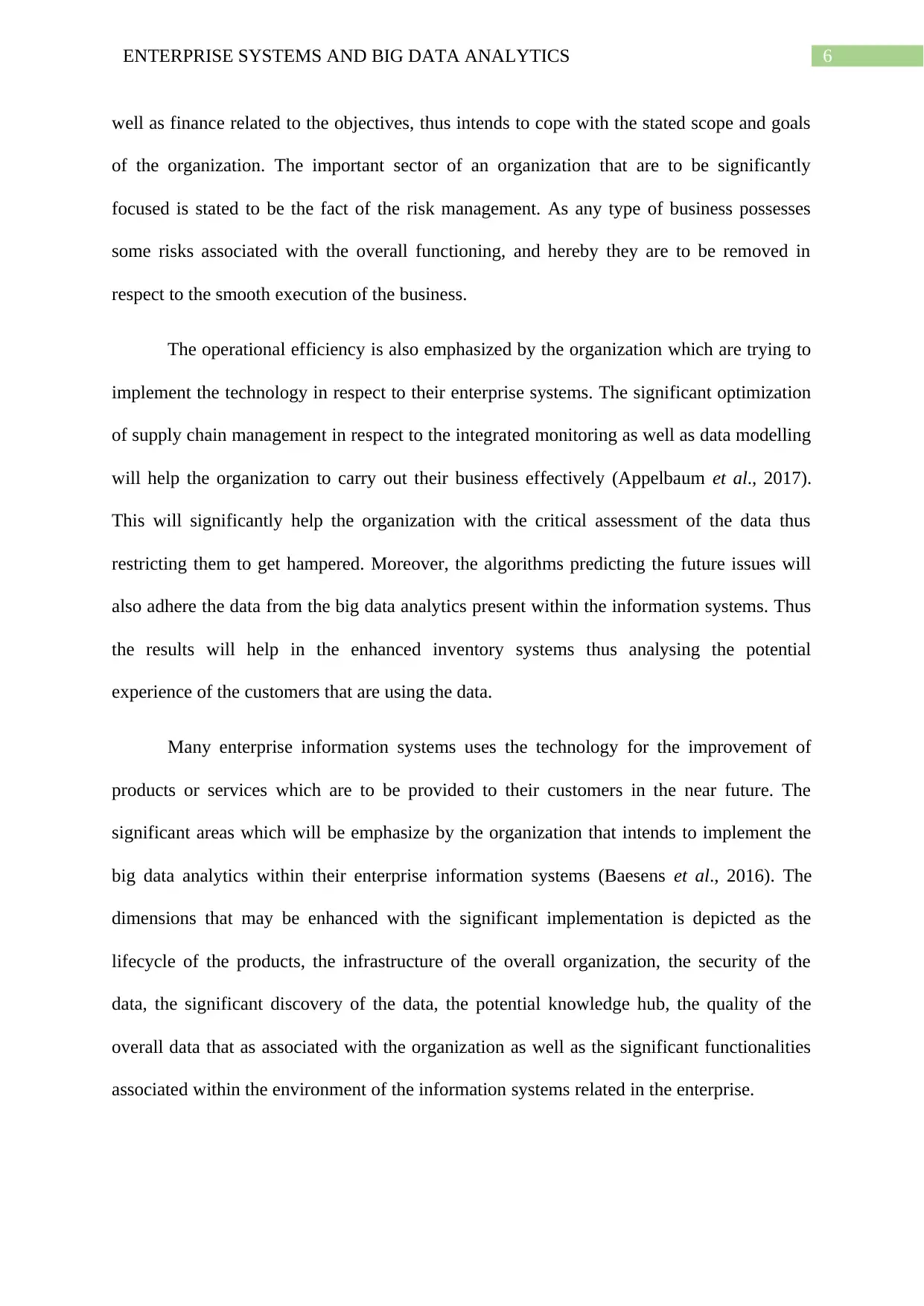
6ENTERPRISE SYSTEMS AND BIG DATA ANALYTICS
well as finance related to the objectives, thus intends to cope with the stated scope and goals
of the organization. The important sector of an organization that are to be significantly
focused is stated to be the fact of the risk management. As any type of business possesses
some risks associated with the overall functioning, and hereby they are to be removed in
respect to the smooth execution of the business.
The operational efficiency is also emphasized by the organization which are trying to
implement the technology in respect to their enterprise systems. The significant optimization
of supply chain management in respect to the integrated monitoring as well as data modelling
will help the organization to carry out their business effectively (Appelbaum et al., 2017).
This will significantly help the organization with the critical assessment of the data thus
restricting them to get hampered. Moreover, the algorithms predicting the future issues will
also adhere the data from the big data analytics present within the information systems. Thus
the results will help in the enhanced inventory systems thus analysing the potential
experience of the customers that are using the data.
Many enterprise information systems uses the technology for the improvement of
products or services which are to be provided to their customers in the near future. The
significant areas which will be emphasize by the organization that intends to implement the
big data analytics within their enterprise information systems (Baesens et al., 2016). The
dimensions that may be enhanced with the significant implementation is depicted as the
lifecycle of the products, the infrastructure of the overall organization, the security of the
data, the significant discovery of the data, the potential knowledge hub, the quality of the
overall data that as associated with the organization as well as the significant functionalities
associated within the environment of the information systems related in the enterprise.
well as finance related to the objectives, thus intends to cope with the stated scope and goals
of the organization. The important sector of an organization that are to be significantly
focused is stated to be the fact of the risk management. As any type of business possesses
some risks associated with the overall functioning, and hereby they are to be removed in
respect to the smooth execution of the business.
The operational efficiency is also emphasized by the organization which are trying to
implement the technology in respect to their enterprise systems. The significant optimization
of supply chain management in respect to the integrated monitoring as well as data modelling
will help the organization to carry out their business effectively (Appelbaum et al., 2017).
This will significantly help the organization with the critical assessment of the data thus
restricting them to get hampered. Moreover, the algorithms predicting the future issues will
also adhere the data from the big data analytics present within the information systems. Thus
the results will help in the enhanced inventory systems thus analysing the potential
experience of the customers that are using the data.
Many enterprise information systems uses the technology for the improvement of
products or services which are to be provided to their customers in the near future. The
significant areas which will be emphasize by the organization that intends to implement the
big data analytics within their enterprise information systems (Baesens et al., 2016). The
dimensions that may be enhanced with the significant implementation is depicted as the
lifecycle of the products, the infrastructure of the overall organization, the security of the
data, the significant discovery of the data, the potential knowledge hub, the quality of the
overall data that as associated with the organization as well as the significant functionalities
associated within the environment of the information systems related in the enterprise.
Paraphrase This Document
Need a fresh take? Get an instant paraphrase of this document with our AI Paraphraser
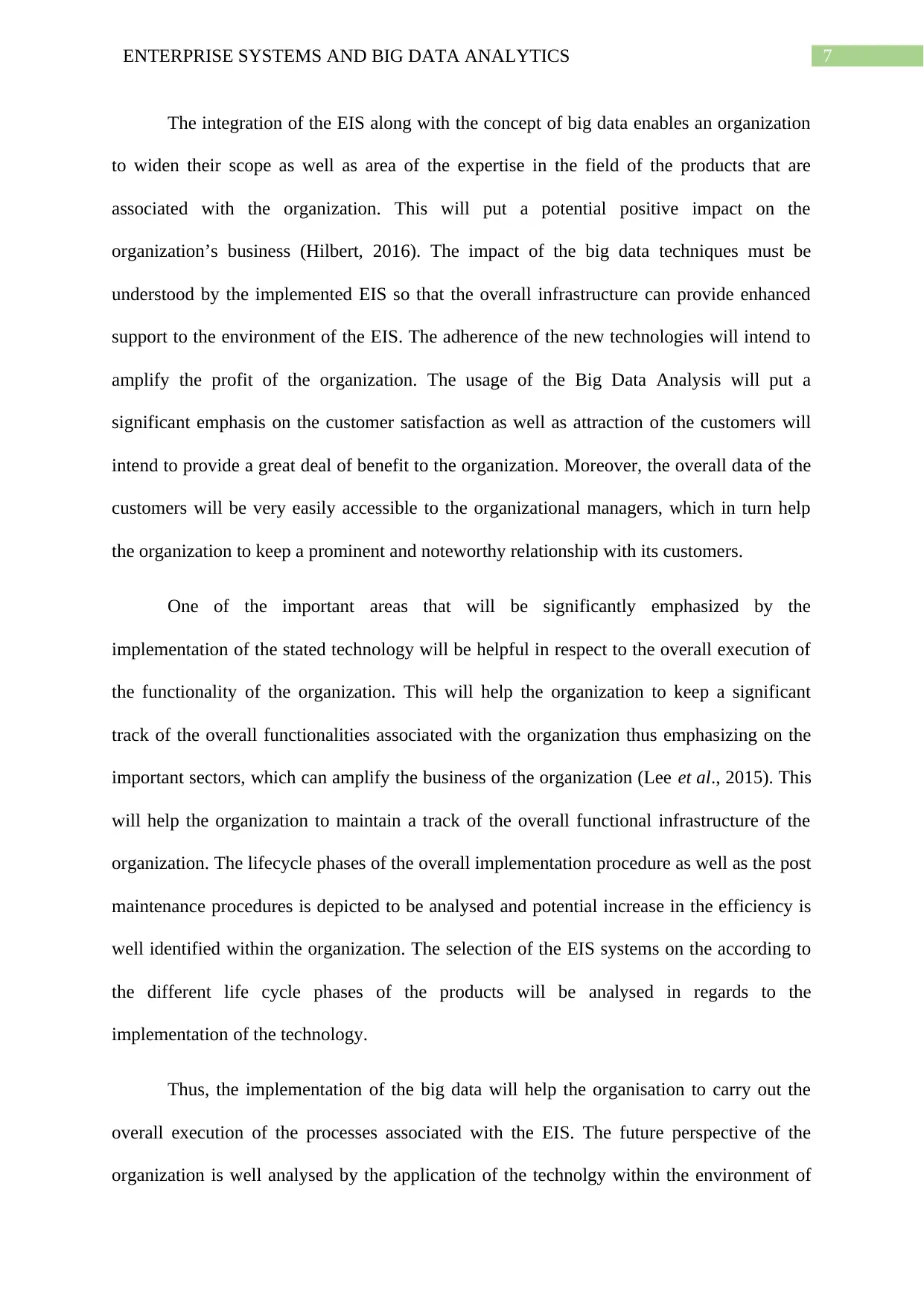
7ENTERPRISE SYSTEMS AND BIG DATA ANALYTICS
The integration of the EIS along with the concept of big data enables an organization
to widen their scope as well as area of the expertise in the field of the products that are
associated with the organization. This will put a potential positive impact on the
organization’s business (Hilbert, 2016). The impact of the big data techniques must be
understood by the implemented EIS so that the overall infrastructure can provide enhanced
support to the environment of the EIS. The adherence of the new technologies will intend to
amplify the profit of the organization. The usage of the Big Data Analysis will put a
significant emphasis on the customer satisfaction as well as attraction of the customers will
intend to provide a great deal of benefit to the organization. Moreover, the overall data of the
customers will be very easily accessible to the organizational managers, which in turn help
the organization to keep a prominent and noteworthy relationship with its customers.
One of the important areas that will be significantly emphasized by the
implementation of the stated technology will be helpful in respect to the overall execution of
the functionality of the organization. This will help the organization to keep a significant
track of the overall functionalities associated with the organization thus emphasizing on the
important sectors, which can amplify the business of the organization (Lee et al., 2015). This
will help the organization to maintain a track of the overall functional infrastructure of the
organization. The lifecycle phases of the overall implementation procedure as well as the post
maintenance procedures is depicted to be analysed and potential increase in the efficiency is
well identified within the organization. The selection of the EIS systems on the according to
the different life cycle phases of the products will be analysed in regards to the
implementation of the technology.
Thus, the implementation of the big data will help the organisation to carry out the
overall execution of the processes associated with the EIS. The future perspective of the
organization is well analysed by the application of the technolgy within the environment of
The integration of the EIS along with the concept of big data enables an organization
to widen their scope as well as area of the expertise in the field of the products that are
associated with the organization. This will put a potential positive impact on the
organization’s business (Hilbert, 2016). The impact of the big data techniques must be
understood by the implemented EIS so that the overall infrastructure can provide enhanced
support to the environment of the EIS. The adherence of the new technologies will intend to
amplify the profit of the organization. The usage of the Big Data Analysis will put a
significant emphasis on the customer satisfaction as well as attraction of the customers will
intend to provide a great deal of benefit to the organization. Moreover, the overall data of the
customers will be very easily accessible to the organizational managers, which in turn help
the organization to keep a prominent and noteworthy relationship with its customers.
One of the important areas that will be significantly emphasized by the
implementation of the stated technology will be helpful in respect to the overall execution of
the functionality of the organization. This will help the organization to keep a significant
track of the overall functionalities associated with the organization thus emphasizing on the
important sectors, which can amplify the business of the organization (Lee et al., 2015). This
will help the organization to maintain a track of the overall functional infrastructure of the
organization. The lifecycle phases of the overall implementation procedure as well as the post
maintenance procedures is depicted to be analysed and potential increase in the efficiency is
well identified within the organization. The selection of the EIS systems on the according to
the different life cycle phases of the products will be analysed in regards to the
implementation of the technology.
Thus, the implementation of the big data will help the organisation to carry out the
overall execution of the processes associated with the EIS. The future perspective of the
organization is well analysed by the application of the technolgy within the environment of
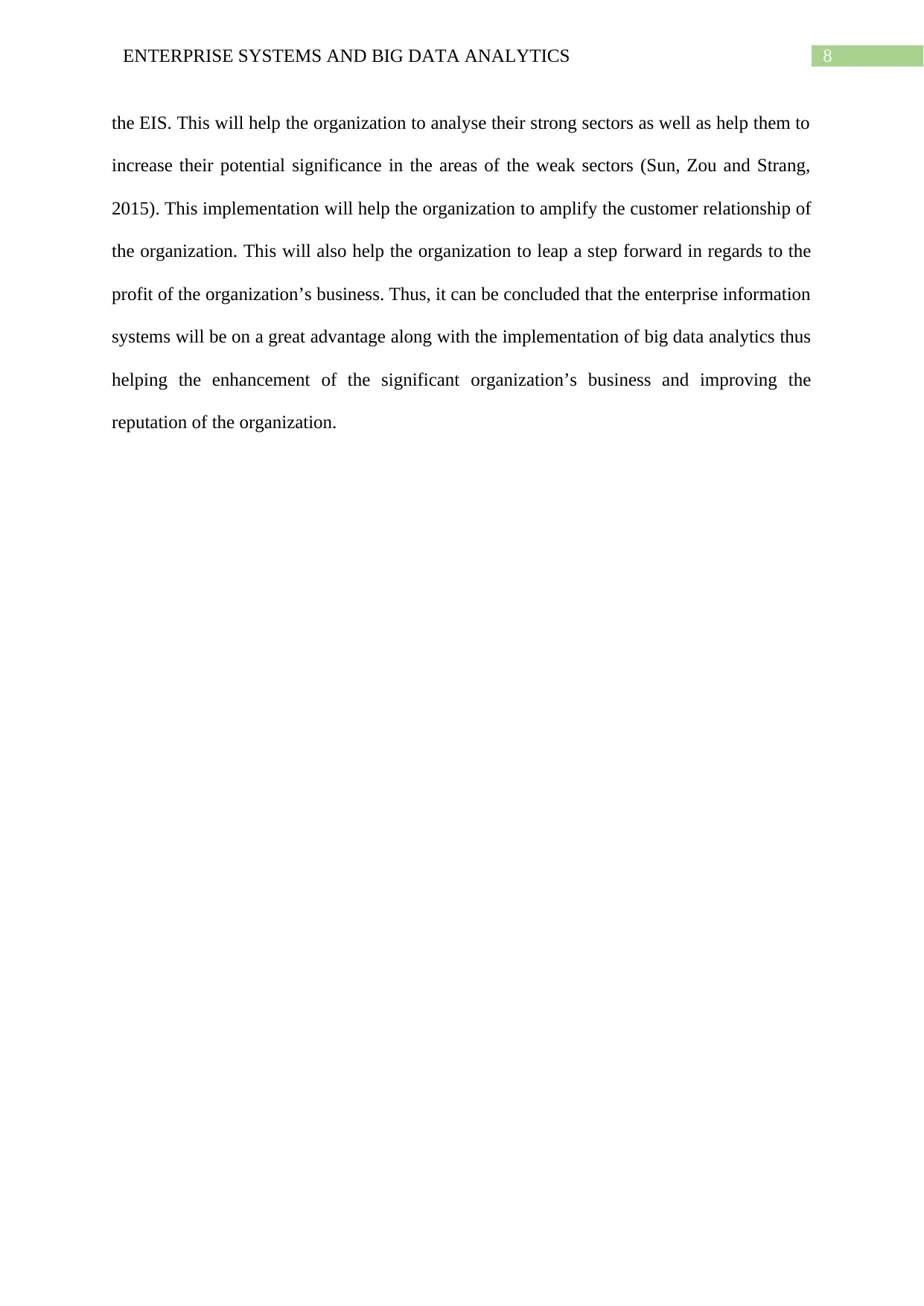
8ENTERPRISE SYSTEMS AND BIG DATA ANALYTICS
the EIS. This will help the organization to analyse their strong sectors as well as help them to
increase their potential significance in the areas of the weak sectors (Sun, Zou and Strang,
2015). This implementation will help the organization to amplify the customer relationship of
the organization. This will also help the organization to leap a step forward in regards to the
profit of the organization’s business. Thus, it can be concluded that the enterprise information
systems will be on a great advantage along with the implementation of big data analytics thus
helping the enhancement of the significant organization’s business and improving the
reputation of the organization.
the EIS. This will help the organization to analyse their strong sectors as well as help them to
increase their potential significance in the areas of the weak sectors (Sun, Zou and Strang,
2015). This implementation will help the organization to amplify the customer relationship of
the organization. This will also help the organization to leap a step forward in regards to the
profit of the organization’s business. Thus, it can be concluded that the enterprise information
systems will be on a great advantage along with the implementation of big data analytics thus
helping the enhancement of the significant organization’s business and improving the
reputation of the organization.
⊘ This is a preview!⊘
Do you want full access?
Subscribe today to unlock all pages.

Trusted by 1+ million students worldwide
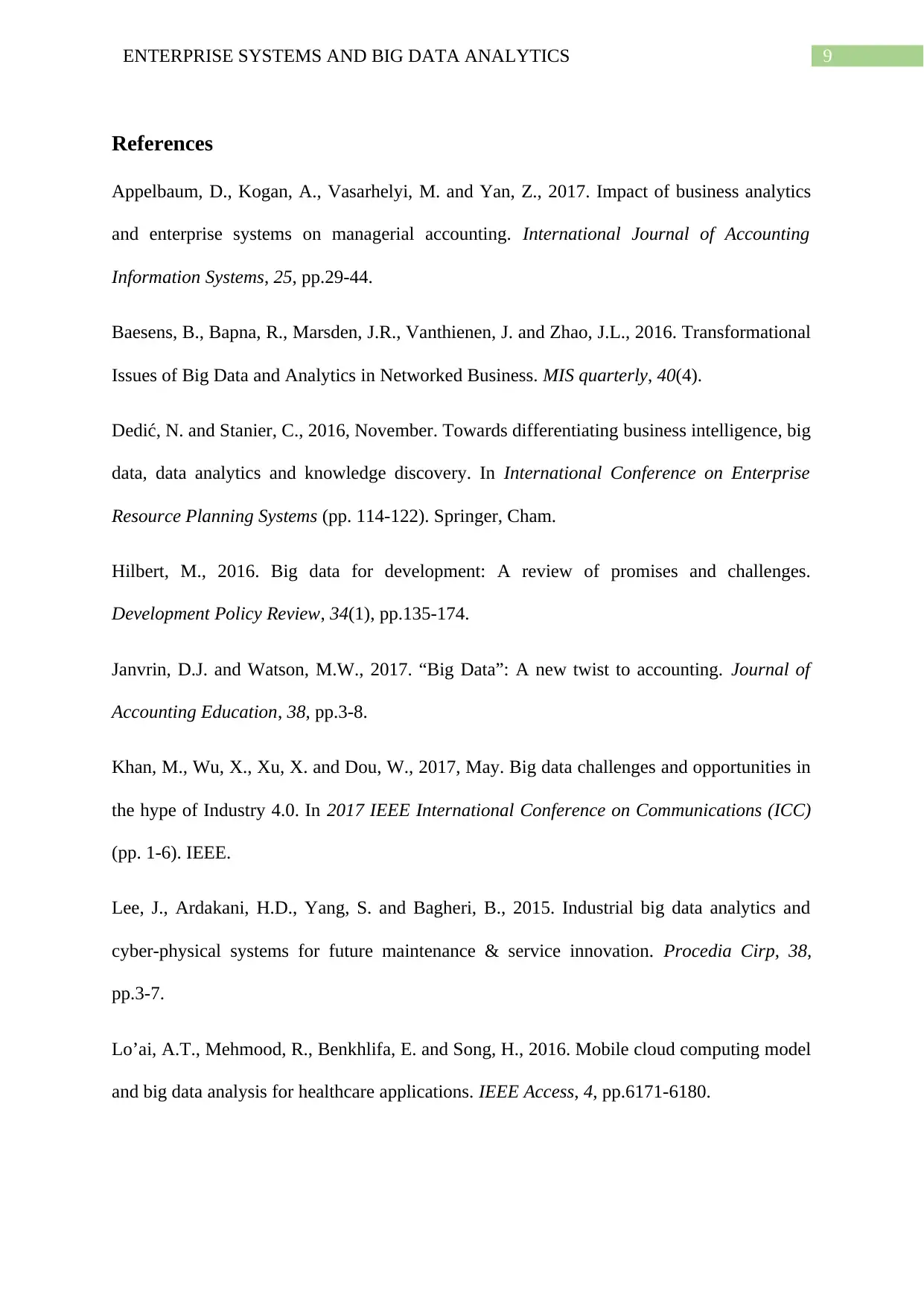
9ENTERPRISE SYSTEMS AND BIG DATA ANALYTICS
References
Appelbaum, D., Kogan, A., Vasarhelyi, M. and Yan, Z., 2017. Impact of business analytics
and enterprise systems on managerial accounting. International Journal of Accounting
Information Systems, 25, pp.29-44.
Baesens, B., Bapna, R., Marsden, J.R., Vanthienen, J. and Zhao, J.L., 2016. Transformational
Issues of Big Data and Analytics in Networked Business. MIS quarterly, 40(4).
Dedić, N. and Stanier, C., 2016, November. Towards differentiating business intelligence, big
data, data analytics and knowledge discovery. In International Conference on Enterprise
Resource Planning Systems (pp. 114-122). Springer, Cham.
Hilbert, M., 2016. Big data for development: A review of promises and challenges.
Development Policy Review, 34(1), pp.135-174.
Janvrin, D.J. and Watson, M.W., 2017. “Big Data”: A new twist to accounting. Journal of
Accounting Education, 38, pp.3-8.
Khan, M., Wu, X., Xu, X. and Dou, W., 2017, May. Big data challenges and opportunities in
the hype of Industry 4.0. In 2017 IEEE International Conference on Communications (ICC)
(pp. 1-6). IEEE.
Lee, J., Ardakani, H.D., Yang, S. and Bagheri, B., 2015. Industrial big data analytics and
cyber-physical systems for future maintenance & service innovation. Procedia Cirp, 38,
pp.3-7.
Lo’ai, A.T., Mehmood, R., Benkhlifa, E. and Song, H., 2016. Mobile cloud computing model
and big data analysis for healthcare applications. IEEE Access, 4, pp.6171-6180.
References
Appelbaum, D., Kogan, A., Vasarhelyi, M. and Yan, Z., 2017. Impact of business analytics
and enterprise systems on managerial accounting. International Journal of Accounting
Information Systems, 25, pp.29-44.
Baesens, B., Bapna, R., Marsden, J.R., Vanthienen, J. and Zhao, J.L., 2016. Transformational
Issues of Big Data and Analytics in Networked Business. MIS quarterly, 40(4).
Dedić, N. and Stanier, C., 2016, November. Towards differentiating business intelligence, big
data, data analytics and knowledge discovery. In International Conference on Enterprise
Resource Planning Systems (pp. 114-122). Springer, Cham.
Hilbert, M., 2016. Big data for development: A review of promises and challenges.
Development Policy Review, 34(1), pp.135-174.
Janvrin, D.J. and Watson, M.W., 2017. “Big Data”: A new twist to accounting. Journal of
Accounting Education, 38, pp.3-8.
Khan, M., Wu, X., Xu, X. and Dou, W., 2017, May. Big data challenges and opportunities in
the hype of Industry 4.0. In 2017 IEEE International Conference on Communications (ICC)
(pp. 1-6). IEEE.
Lee, J., Ardakani, H.D., Yang, S. and Bagheri, B., 2015. Industrial big data analytics and
cyber-physical systems for future maintenance & service innovation. Procedia Cirp, 38,
pp.3-7.
Lo’ai, A.T., Mehmood, R., Benkhlifa, E. and Song, H., 2016. Mobile cloud computing model
and big data analysis for healthcare applications. IEEE Access, 4, pp.6171-6180.
Paraphrase This Document
Need a fresh take? Get an instant paraphrase of this document with our AI Paraphraser
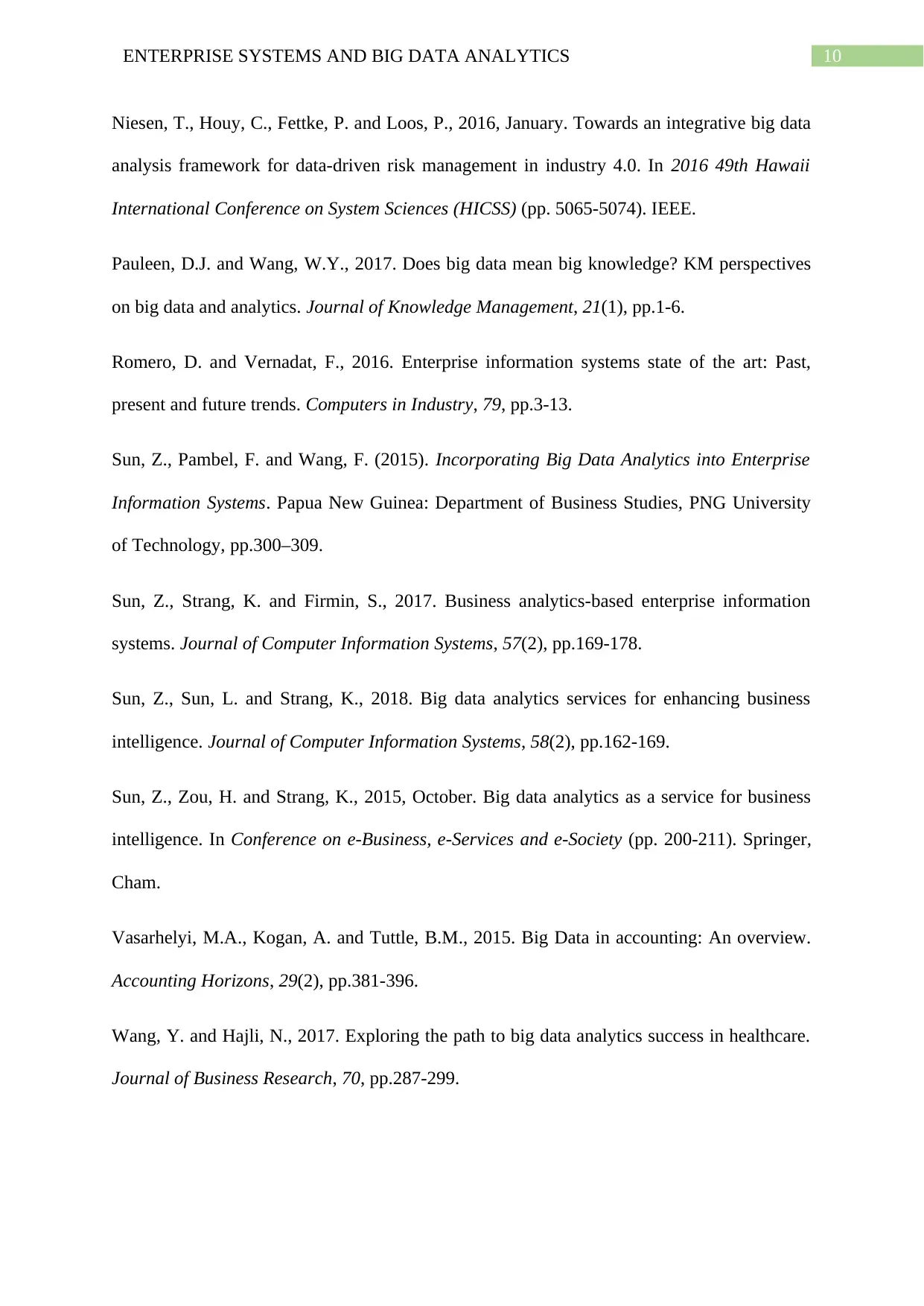
10ENTERPRISE SYSTEMS AND BIG DATA ANALYTICS
Niesen, T., Houy, C., Fettke, P. and Loos, P., 2016, January. Towards an integrative big data
analysis framework for data-driven risk management in industry 4.0. In 2016 49th Hawaii
International Conference on System Sciences (HICSS) (pp. 5065-5074). IEEE.
Pauleen, D.J. and Wang, W.Y., 2017. Does big data mean big knowledge? KM perspectives
on big data and analytics. Journal of Knowledge Management, 21(1), pp.1-6.
Romero, D. and Vernadat, F., 2016. Enterprise information systems state of the art: Past,
present and future trends. Computers in Industry, 79, pp.3-13.
Sun, Z., Pambel, F. and Wang, F. (2015). Incorporating Big Data Analytics into Enterprise
Information Systems. Papua New Guinea: Department of Business Studies, PNG University
of Technology, pp.300–309.
Sun, Z., Strang, K. and Firmin, S., 2017. Business analytics-based enterprise information
systems. Journal of Computer Information Systems, 57(2), pp.169-178.
Sun, Z., Sun, L. and Strang, K., 2018. Big data analytics services for enhancing business
intelligence. Journal of Computer Information Systems, 58(2), pp.162-169.
Sun, Z., Zou, H. and Strang, K., 2015, October. Big data analytics as a service for business
intelligence. In Conference on e-Business, e-Services and e-Society (pp. 200-211). Springer,
Cham.
Vasarhelyi, M.A., Kogan, A. and Tuttle, B.M., 2015. Big Data in accounting: An overview.
Accounting Horizons, 29(2), pp.381-396.
Wang, Y. and Hajli, N., 2017. Exploring the path to big data analytics success in healthcare.
Journal of Business Research, 70, pp.287-299.
Niesen, T., Houy, C., Fettke, P. and Loos, P., 2016, January. Towards an integrative big data
analysis framework for data-driven risk management in industry 4.0. In 2016 49th Hawaii
International Conference on System Sciences (HICSS) (pp. 5065-5074). IEEE.
Pauleen, D.J. and Wang, W.Y., 2017. Does big data mean big knowledge? KM perspectives
on big data and analytics. Journal of Knowledge Management, 21(1), pp.1-6.
Romero, D. and Vernadat, F., 2016. Enterprise information systems state of the art: Past,
present and future trends. Computers in Industry, 79, pp.3-13.
Sun, Z., Pambel, F. and Wang, F. (2015). Incorporating Big Data Analytics into Enterprise
Information Systems. Papua New Guinea: Department of Business Studies, PNG University
of Technology, pp.300–309.
Sun, Z., Strang, K. and Firmin, S., 2017. Business analytics-based enterprise information
systems. Journal of Computer Information Systems, 57(2), pp.169-178.
Sun, Z., Sun, L. and Strang, K., 2018. Big data analytics services for enhancing business
intelligence. Journal of Computer Information Systems, 58(2), pp.162-169.
Sun, Z., Zou, H. and Strang, K., 2015, October. Big data analytics as a service for business
intelligence. In Conference on e-Business, e-Services and e-Society (pp. 200-211). Springer,
Cham.
Vasarhelyi, M.A., Kogan, A. and Tuttle, B.M., 2015. Big Data in accounting: An overview.
Accounting Horizons, 29(2), pp.381-396.
Wang, Y. and Hajli, N., 2017. Exploring the path to big data analytics success in healthcare.
Journal of Business Research, 70, pp.287-299.

11ENTERPRISE SYSTEMS AND BIG DATA ANALYTICS
Wang, Y., Kung, L. and Byrd, T.A., 2018. Big data analytics: Understanding its capabilities
and potential benefits for healthcare organizations. Technological Forecasting and Social
Change, 126, pp.3-13.
Zhang, Y., Ren, S., Liu, Y. and Si, S., 2017. A big data analytics architecture for cleaner
manufacturing and maintenance processes of complex products. Journal of Cleaner
Production, 142, pp.626-641.
Wang, Y., Kung, L. and Byrd, T.A., 2018. Big data analytics: Understanding its capabilities
and potential benefits for healthcare organizations. Technological Forecasting and Social
Change, 126, pp.3-13.
Zhang, Y., Ren, S., Liu, Y. and Si, S., 2017. A big data analytics architecture for cleaner
manufacturing and maintenance processes of complex products. Journal of Cleaner
Production, 142, pp.626-641.
⊘ This is a preview!⊘
Do you want full access?
Subscribe today to unlock all pages.

Trusted by 1+ million students worldwide
1 out of 12
Related Documents
Your All-in-One AI-Powered Toolkit for Academic Success.
+13062052269
info@desklib.com
Available 24*7 on WhatsApp / Email
![[object Object]](/_next/static/media/star-bottom.7253800d.svg)
Unlock your academic potential
Copyright © 2020–2025 A2Z Services. All Rights Reserved. Developed and managed by ZUCOL.





